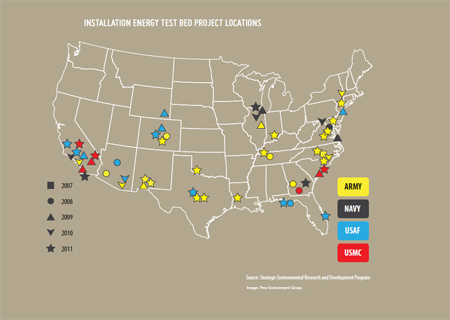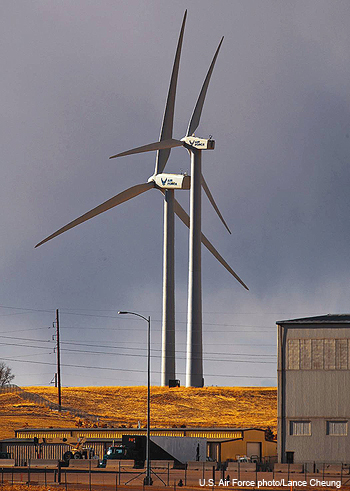Pew Study: Department of Defense Accelerates Clean Energy Innovation to Save Lives, Money
Investments focus on vehicle technologies, advanced biofuels and energy efficiency
The U.S. Department of Defense (DoD) is accelerating clean energy innovations in an effort to reduce risks to America's military, enhance energy security and save money, according to a report released today by The Pew Charitable Trusts. “From Barracks to the Battlefield: Clean Energy Innovation and America's Armed Forces” finds that DoD clean energy investments increased 200 percent between 2006 and 2009, from $400 million to $1.2 billion, and are projected to eclipse $10 billion annually by 2030.
“As one of the largest energy consumers in the world, the Department of Defense has the ability to help shape America's energy future,” said Phyllis Cuttino, director of the Pew Clean Energy Program. “DoD's efforts to harness clean energy will save lives, save money and enhance the nation's energy and economic future. Their work is also helping to spur the growth of the clean energy economy.”
 The department's priorities for energy efficiency and renewable energy sources have been driven by recent experience in Iraq and Afghanistan, where fuel shipments account for 80 percent of all supply convoys. As many as one in 46 convoys suffered a casualty in fiscal 2010. The report finds that DoD's major energy challenges include risks associated with transporting liquid fuels to the battlefield, growing oil price volatility, the impact of fuel dependence on operational effectiveness, the fragility of energy supplies and compliance with energy policies set by Congress and Presidents George W. Bush and Barack Obama.
The department's priorities for energy efficiency and renewable energy sources have been driven by recent experience in Iraq and Afghanistan, where fuel shipments account for 80 percent of all supply convoys. As many as one in 46 convoys suffered a casualty in fiscal 2010. The report finds that DoD's major energy challenges include risks associated with transporting liquid fuels to the battlefield, growing oil price volatility, the impact of fuel dependence on operational effectiveness, the fragility of energy supplies and compliance with energy policies set by Congress and Presidents George W. Bush and Barack Obama.
“For the Department of the Navy to meet the challenges we face in the 21st century, we must reduce our dependence on foreign oil and find ways to use energy more efficiently,” stated Navy Secretary Ray Mabus. “We must ensure that we remain the most formidable expeditionary force in the world, even in these challenging economic times. We can do that in part by changing the way we use, acquire and produce energy. Before the end of the decade, our programs to develop and use alternative sources of energy, on shore and at sea, will pay for themselves. We will save the department money, but more importantly, these energy initiatives will make us better war fighters and will saves lives.”
John W. Warner, a five-term U.S. senator from Virginia and senior policy adviser to the Pew Project on National Security, Energy and Climate, added, “The Department of Defense fostered the Internet, GPS, computer software and other economically important innovations. Today, our uniformed men and women and their civilian counterparts are committed to transforming the way the department uses energy through efficiency and technology development. Their accomplishments and innovations are enhancing our national, economic and environmental security.”
 The Pew report documents how DoD is helping to accelerate the development and deployment of clean energy technologies in three key areas: vehicle efficiency, advanced biofuels and energy efficiency and renewable energy at bases.
The Pew report documents how DoD is helping to accelerate the development and deployment of clean energy technologies in three key areas: vehicle efficiency, advanced biofuels and energy efficiency and renewable energy at bases.
Vehicle Efficiency: Liquid petroleum fuels account for approximately three-quarters ($11 billion) of DoD's $15 billion annual energy bill. DoD spending to harness clean energy technologies for air, land and sea vehicles is projected to grow to $2.25 billion annually by 2015. To achieve its goal of increasing efficiency and reducing fuel consumption on ships by 15 percent between 2010 and 2020, the Navy is using hybrid electric technologies, improving hull coatings and using more efficient materials. A hybrid electric drive system will be tested on the U.S.S. Truxtun, a missile guided destroyer, and is expected to save 8,500 barrels of fuel annually. Recent operational improvements to enhance efficiency will save the department $500 million this fiscal year alone.
Advanced Biofuels: DoD has set ambitious goals and is taking concrete steps to utilize advanced biofuels. The Air Force intends to use biofuels for 50 percent of its domestic aviation needs by 2016. The Navy plans to sail a “Great Green Fleet” and, along with the Marines, plans to use alternative energy sources to meet 50 percent of its energy requirements across operational platforms by 2020. In order to reach these goals, DoD has accelerated research on advanced biofuels, successfully testing and certifying them for use in existing fighter jets and ships.
Energy efficiency and renewables at bases: With more than 500,000 buildings and structures at 500 major installations around the world, DoD manages three times the square footage operated by Wal-Mart Stores Inc. Since 1985, DoD has reduced its facility energy consumption by more than 30 percent. By insulating 9 million square feet of base structures in Iraq and Afghanistan, energy consumption has been reduced by 77,000 gallons per day. Another initiative is the Army's “Net Zero” program which aims to have each of six installations produce as much as they consume in energy, water or waste by 2020, and two other installations, Fort Bliss in Texas and Fort Carson in Colorado, will become net zero in all three areas.
DoD has 450 ongoing renewable energy projects producing or procuring 9.6 percent of its energy from clean sources in fiscal year 2010. Renewable energy spending by the department is projected to reach $3 billion by 2015 and $10 billion by 2030. The military's implementation of smart microgrids will grow by 375 percent to $1.6 billion annually in 2020. Market analysts indicate that the DoD will account for almost 15 percent of the microgrid market in 2013.











